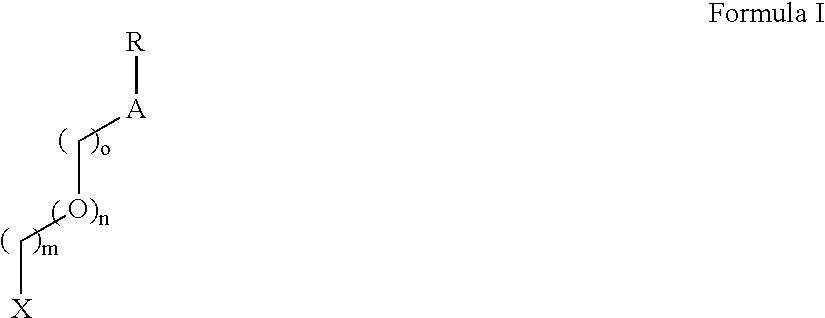Water-repellent and soil-resistant finish for textiles
- Summary
- Abstract
- Description
- Claims
- Application Information
AI Technical Summary
Benefits of technology
Problems solved by technology
Method used
Image
Examples
example 1
3.603 Grams of acrylic acid, 8.931 g FX-13 (3M), 0.106 g AIBN, and 0.483 g mercaptosuccinic acid were dissolved in 29.565 g THF. While stirring, the reaction vessel was purged with nitrogen for a few minutes. The mixture was then heated and held at reflux for 16 hours. The THF / polymer solution may either be used directly or the THF may be removed by rotary evaporation, leaving the “20-mer” polymer behind.
example 2
A 0.232 M solution of ZrO(NO3)2 in 95% water / 5% isobutanol was padded onto wool. The wool was then dried at 90° C. Next, a solution of 1.76 g fluoropolymer (4 parts acrylic acid, 1 part FX-13, 1% mercaptosuccinic acid, “100-mer”; prepared following the procedure of Example 1) at pH 6.9 in 95% water / 5% isobutanol was padded onto wool. The wool was again dried at 90° C. The material was then rinsed for 3 minutes under flowing tap water and dried in the oven at 90° C. The sample was immersed (overnight) in a stirred vessel containing tetrachloroethylene to test the stability of the coating. It was then removed and allowed to dry in the air.
Test for repellency showed that dodecane, water, and an 81% methanol / water mixture beaded up on the surface. Decane wet it.
example 3
64 Grams of Zonyl TA-N (a fluorochemical acrylate from DuPont), 18 g stearyl acrylate, 15 g polyethylene glycol monoacrylate (Aldrich, Mn˜375), 3 g calcium acrylate, 0.5 g dodecanethiol, 8 g POE(14) monostearate, 1 g 2,2′-azobis(2-methylpropionamidine) dihydrochloride, 100 g isopropyl alcohol, and 100 g water were homogenized. The calcium acrylate was dissolved in water before it was added. The mixture was then homogenized and heated under nitrogen to 70-80° C. for about 2 hr. This solution was diluted to 20% of its original concentration with water and applied to wool (Burlington Industries 8823 tan wool). The wool was padded to ˜100% wet pickup and dried and cured in an oven for 18 min. The temperature in the oven rose during this period from 105° C. to 140° C. The water and oil repellencies of these samples were then measured both before and after immersion in rapidly-stirred tetrachloroethylene (TCE). The following Table gives the oil repellency as measured by the AATCC test met...
PUM
| Property | Measurement | Unit |
|---|---|---|
| Electrical resistance | aaaaa | aaaaa |
| Hydrophilicity | aaaaa | aaaaa |
| Durability | aaaaa | aaaaa |
Abstract
Description
Claims
Application Information
 Login to View More
Login to View More - R&D
- Intellectual Property
- Life Sciences
- Materials
- Tech Scout
- Unparalleled Data Quality
- Higher Quality Content
- 60% Fewer Hallucinations
Browse by: Latest US Patents, China's latest patents, Technical Efficacy Thesaurus, Application Domain, Technology Topic, Popular Technical Reports.
© 2025 PatSnap. All rights reserved.Legal|Privacy policy|Modern Slavery Act Transparency Statement|Sitemap|About US| Contact US: help@patsnap.com



